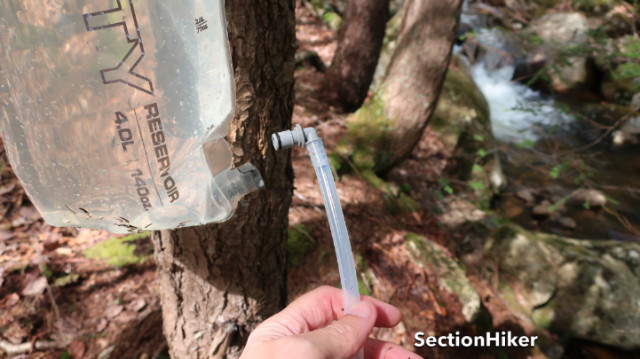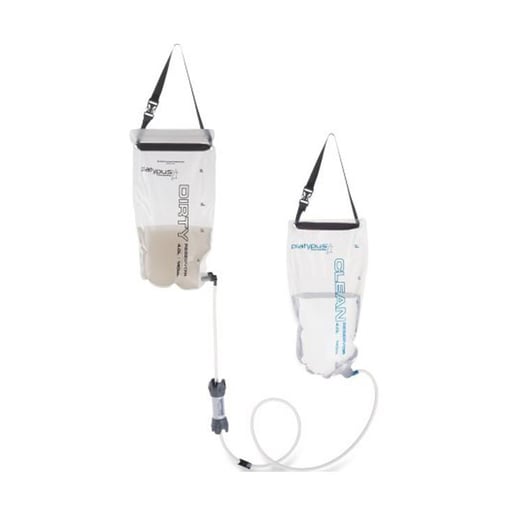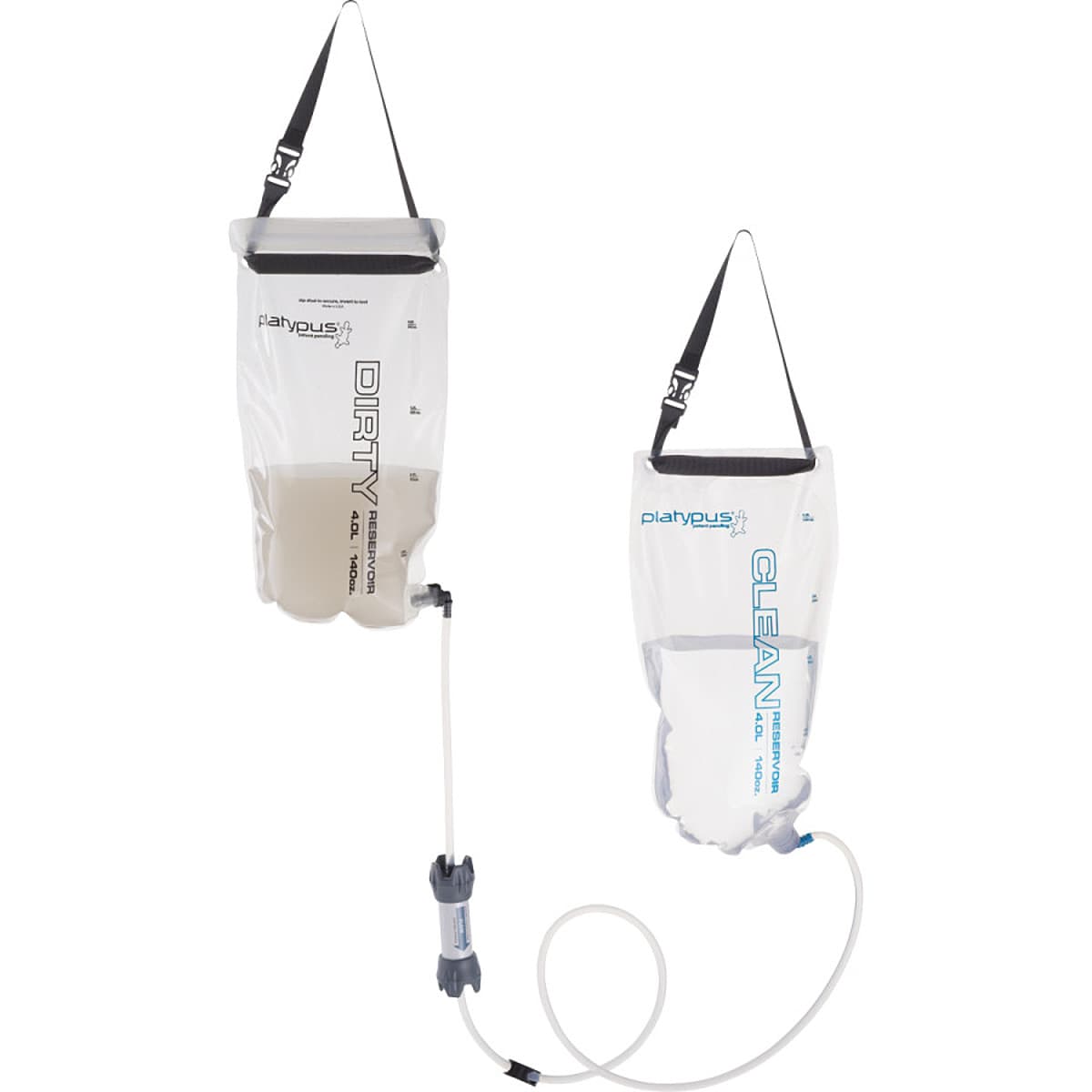
The Platypus GravityWorks Water Filter is a complete and well-integrated water filter that includes all of the components required to set up a gravity-based water filter system. Gravity water filters are good for filtering several liters backcountry water at once for consumption by families or groups. It’s basically a batch approach to water filtering and eliminates the need to pump or squeeze water through the filter one liter at a time. The Gravity Works system includes a water filter, hosing, quick-connectors, a handy hose shut-off valve, and two 4 liter platypus hydration reservoirs for holding “dirty” pre-filtered water and “clean” post-filtered water. It’s all color-coded and very well documented making it a great system for people who aren’t familiar with water filtration or only do it occassionally.
Specs at a Glance
- Weight: 12 oz / 340g
- Flow rate 1.75 liters/minute
- Filter life: 1500 liters
- Filter media: Hollow fiber membrane
- Filter pore size: 0.2 microns
- Filter efficacy: remove 99.9999% of bacteria and 99.9% of protozoa including giardia and cyptosporidium
- Temperature range: Above 32 F/0C (do not freeze)
- Contents: quick disconnect fitting, clean reservoir with clean cap, filter cartridge, dirty hose (12 in /30 cm), clean hose (48″ / 122 cm), shut-off clamp, clean side clamp, storage sack w/ instructions printed inside
- Field cleanable: Yes (backflush)
- Water bottle adapter: No
- Cartridge replacement indicator: No
- Field filter integrity test: Yes
Gravity-based filtration systems work by using gravity to force the “dirty” un-filtered water stored in a reservoir through a water filter and into a “clean” water reservoir. It’s not quite as simple as that though. Water bubbles can form in the hose between the filter and the reservoirs and cripple the flow rate, the filter can require cleaning if you filter a lot of silty water, and it’s easy to cross-contaminate the dirty and clean parts of the system if you’re not careful to keep them separate. Platypus has factored all of those issues into the Gravity Works design though, so they’re easily and safely addressed.

Gravity filter systems like this are very good to use if you need to filter a large amount of water at once and don’t want to have to pump it all through a filter or wait for your water while chemicals kill the microscopic bad stuff in it. When I say large, I mean anywhere from 6 liters for 2 people camping at night, up to 24 liters for an 8 person scout troop (or more), where you really want to make sure everyone has clean water. You can also use this gravity filter setup for one person, but it’s really intended for use by couples or a group use. Platypus sells a lighter weight 2L version of the GravityWorks system for personal use.

How it Works
The GravityWorks System comes with two reservoirs, one labelled DIRTY and one marked CLEAN so you can’t confuse them. Water is collected from a stream or river in the dirty reservoir, the one marked DIRTY, and then hung up in a tree from a strap. The dirty bag uses a Platypus 4 liters (1 gallon) Water Tank-style zip-lock style opening so it’s easy to fill in-stream without having to scoop 4 liters of water up by hand. That’s a nice touch, really. Simply find a small stream pour over and fill it up.

The next step is to attach the end of the hose that feeds the filter to the bag marked “DIRTY”. This is done using a color coded quick connect that prevents you from getting water all over yourself. Simply slide the male end into the female end and listen for the click.

The clean side of the hose is connected to the filter (note the direction of flow arrow on the filter cartridge) and feeds into the clean bag, marked “CLEAN.” There’s only one way that clean water can enter the clean reservoir and it’s impossible to misconfigure.
Once everything is connected, put the clean bag below the dirty bag and let the filtering begin. Once there are few inches of water in the clean bag, it’s good to lift the clean bag above the dirty bag so that any air bubbles in the hose or filter element can bubble up and back into the dirty bag. This also serves to backflush the filter and prevent clogging. If you do this for a minute every time you use the filter, it will maintain a good flow rate. Once the bubbles stop, lower the clean reservoir and let the filtering complete.

From there, you can decant the clean bag into smaller water containers or use the hose to pour clean water into a cook pot. Platypus also includes a cap for the clean bag; so you can simply cap it off and save the water for use later.
Usage Tips
You don’t have to hang the dirty and clean bags from a tree branch: in fact, you’d be amazed at how difficult it is to find a single stubby branch, let alone two, that are strong and short enough to hang a reservoir from. Instead, you can simply position the dirty bag on a hill or rock, so it’s higher than the clean bag. Doing this can be advantageous even in tree country because it’s a lot easier to lift the clean bag above the dirty bag in order to backflush the filter and clear the line of air bubbles before each use.
When you’re finished using the GravityWorks system and ready to stow it in your pack, the best thing to do is to stack the two bladders, connect all the hosing, and simply roll it all up together. It will be wet, so stow it in an external mesh pocket on your backpack, preferably on the front of the pack so that it won’t drop on your pants as you walk. Platypus includes a lightweight mesh bag with the kit that you can use to hold everything together which has an attached sheet of instructions to refresh your memory if you’re out of practice.

I also make a point to rinse out any accumulated muck (sand, leaves, etc) at the bottom of the dirty bag before storage, so it’s reasonably clean before I use it the next time. After you’ve packed everything away, be sure to wash your hands with soap or clean them with hand sanitizer to prevent the ingestion of bacteria or protozoa.
Flow Rate
No gravity filter review would be complete without some flow rate testing. On average, the Platypus Water Filter takes 45 seconds to filter a liter of water, which is pretty fast in my book, but I’ve done all of my benchmarks with stream water that has had suspended solids in it. The benchmark that Platypus publishes is much faster at 1.75 L / min, but I reckon that’s done with purified water which you’re unlikely to find in the backcountry. Either way, this is excellent performance and you can filter a whole lot of 1-gallon batches with the GravityWorks system in a relatively short period of time.
More Gravity Filter Systems
| Make / Model | Type | Capacity | Reservoirs |
|---|---|---|---|
| Platypus Gravity Works 2L | Filter | 2L | 2 |
| Platypus Gravity Works 4L | Filter | 4L | 2 |
| Platypus Gravity Works 6L | Filter | 6L | 2 |
| Katadyn BeFree Water Filtration System 3L | Filter | 3L | 1 |
| Katadyn BeFree Water Filtration System 6L | Filter | 6L | 1 |
| Katadyn BeFree Water Filtration System 10L | Filter | 10L | 1 |
| MSR Trail Base Water Filter Kit | Filter | 2L | 2 |
| Sawyer Gravity Water Filtration System | Filter | 4L | 1 |
| CNOC Vecto and Versa Flow Gravity Kit | Filter | 3L | 2 |
| CNOC Vecto and Versa Flow Gravity Kit | Filter | 2L | 2 |
| MSR AutoFlow XL Gravity Filter | Filter | 10L | 1 |
| Lifestraw Mission Gravity Water Purifier | Purifier | 12L | 1 |
| MSR Guardian Gravity Purifier | Purifier | 10L | 1 |
Integrity Testing
If you ever become concerned about the safety of the Platypus GravityWorks Filter and wonder if it’s still working, you can field test the filter element by blowing into the clear hose to see if air passes through it (it shouldn’t). For example, it’s important to keep the filter from freezing in temperatures below 32 degrees Fahrenheit/0 degrees Celsius. If you think the filter has been compromised by freezing you can test it right away.
Recommendation
The Platypus GravityWorks Water Filter System is a very well thought out gravity filter system that’s good for couples or larger groups of hikers who need to have a large amount of water filtered quickly on the go. It’s also well labeled and only fits together one way, the right way, in order to prevent contaminating clean components with dirty water. Bravo to Platypus on the design; they’ve obviously incorporated a lot of field testing and product feedback back into the design and it shows.
Disclosure: Cascade Designs donated a gravity filter for this review.
Compare 5 Prices
-

 Amazon US
Amazon US$134.94$101.43ViewAmazon.com Price: $101.43 (as of 04/19/2024 01:11 GMT-0400) Details
Product prices and availability are accurate as of the date/time indicated and are subject to change. Any price and availability information displayed on Amazon.com at the time of purchase will apply to the purchase of this product.
-

 Eastern Mountain Sports$125.95View
Eastern Mountain Sports$125.95View -
 REI$134.95View
REI$134.95View -

 Sportsman's Warehouse$134.95View
Sportsman's Warehouse$134.95View -

 Backcountry.com$134.95View
Backcountry.com$134.95View -

 Eastern Mountain Sports$134.95View
Eastern Mountain Sports$134.95View
SectionHiker is reader-supported. We only make money if you purchase a product through our affiliate links. Help us continue to test and write unsponsored and independent gear reviews, beginner FAQs, and free hiking guides.
 SectionHiker.com Backpacking Gear Reviews and FAQs
SectionHiker.com Backpacking Gear Reviews and FAQs 
Hi, Phillip:
How significant is pore size for a filter?
I notice that this is a .2 micron filter, while the Sawyer is a .1 micron filter. However, both filters are rated to remove 99.9999% of bacteria and 99.99% of protozoa. This makes me think that the difference is negligible between what the .1 micron filter will remove and what the .2 micron filter will remove.
0.2 micron will flow faster. That’s the same pore size as the Katadyn BeFree filter, which is significantly faster than using a Sawyer Mini or Squeeze. I’ve stopped using my Sawyer filters because they are a pain in the butt to squeeze compared to the BeFree. There is a slight difference in filtration if you compare the published numbers, but for me it matters much less than water source and self-contamination from hands or spilled water.
I think it’s hard to generalize the difference beyond these specific filters. I would rely on the EPA test scores (the percentage removed). If they’re the same, then any product difference is moot.
Actually Platypus claim 99.9999% of bacteria and 99.9% of protozoa for this filter and Sawyer claim 99.99999% of bacteria and 99. 9999% of protozoa for the Squeeze…so not the same. It is odd that less of the larger protozoa are removed! Sawyer claims of 0.1 micron “absolute” (presumably not larger pores than 0.1 micron) which is small enough that it should filter some of the larger viruses but not small enough to make any guarantee to filter the ones that may be of general concern. That requires <0.01 microns I think. Other filters generally claim a nominal 0.2 micron size…presumable an average. In practice in the US back country the difference is not significant since we are told we need not generally be concerned about water borne viruses in the back country (ymmv)
I have had one of these for over five years and our crews of 12 used them exclusively for weeks in back country. A tip I will offer is don’t let anyone use it without training. Had a few complain about the flow rate and they didn’t follow the run, back flush, run instructions.
They ended up using the 4L bag like a big Sawyer squeeze bag and destroyed the top seal on the dirt bag.
My one complaint, Platypus doesn’t offer spare parts. But it all, throw away mentality.
I’ve had one of these for several years and really like it. My only complaint, a minor one, is that the caps for the fittings on the filter are both the same color, black. It seems to me that one should be black or gray (DIRTY) and the other blue or white (CLEAN) to avoid contamination from putting the DIRTY cap on the CLEAN side. I suppose I should mark one of them myself with nail polish or some such thing.
Mine only came with one cap, a black one. But it’s a non-issue if you just keep the filter connected to the hoses. I just roll both reservoirs up with the filter and hoses when I pack it up so it’s ready to deploy when I need it. It is an exceptional product.
Very helpful tip on integrity testing! I’m going to give this a try right away after an unexpectedly cold night last Fall.
I combined a BeFree filter with a CNOC 3 liter bag and hang it on a tree with zingit cord. It works great.
I do the same thing with my Sawyer Squeeze. I’m always puzzled when people imply that one can’t use one of these other types of filters as a gravity filter.
I’ve been using this system when canoe camping for a couple of years. I agree with the information in the review and have been very pleased with the system from day one. Last year I purchased an additional “clean” bag and between that and my water bottles, I can have enough filtered water for several days. I particularly like to do this when the best water source is not the lake, pond or river I am camped on (but rather a clearer running feeder stream that’s enroute or nearby the site). This way I don’t have to rely on what’s immediately at hand and can bring better quality water back to camp.